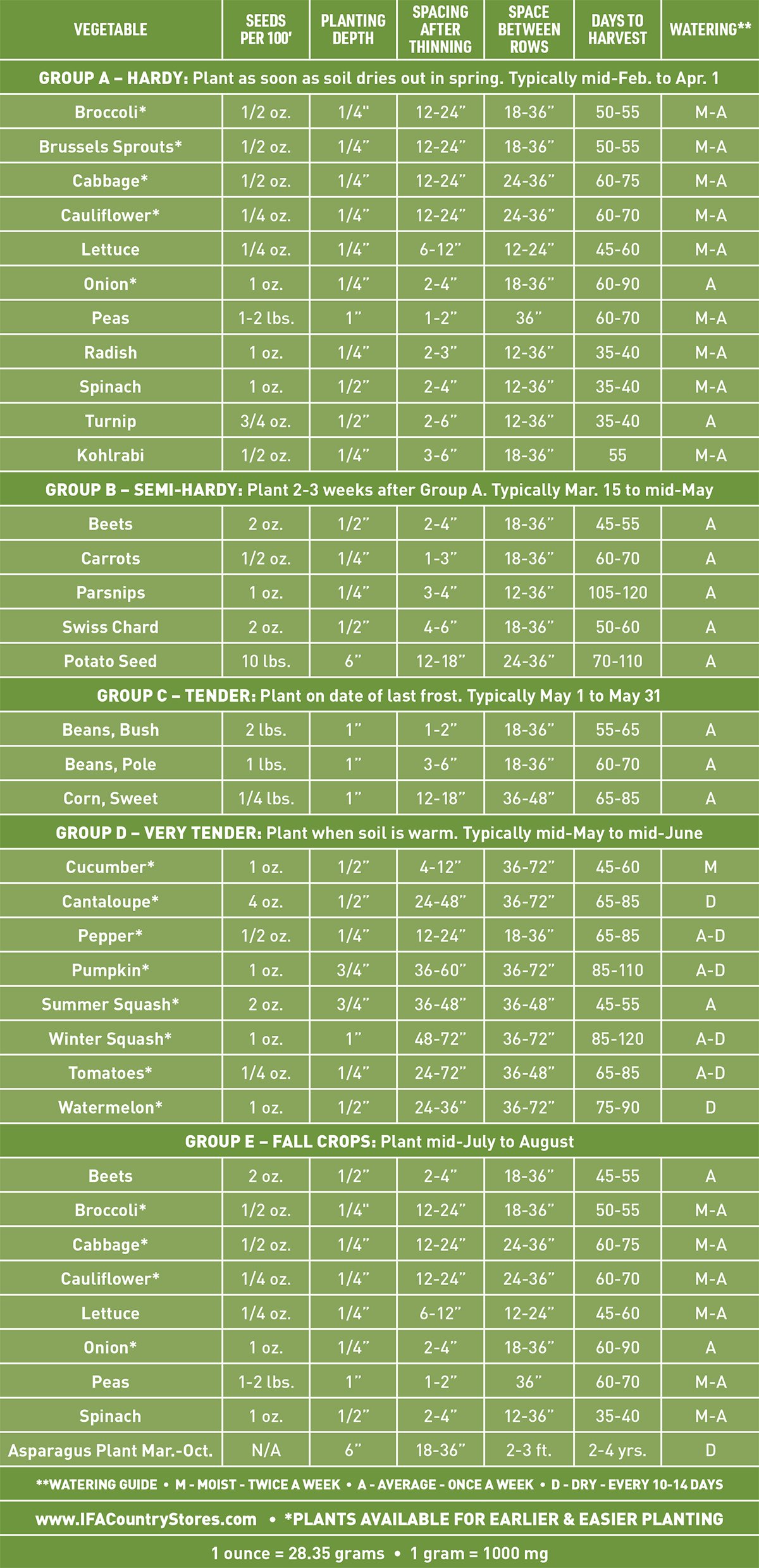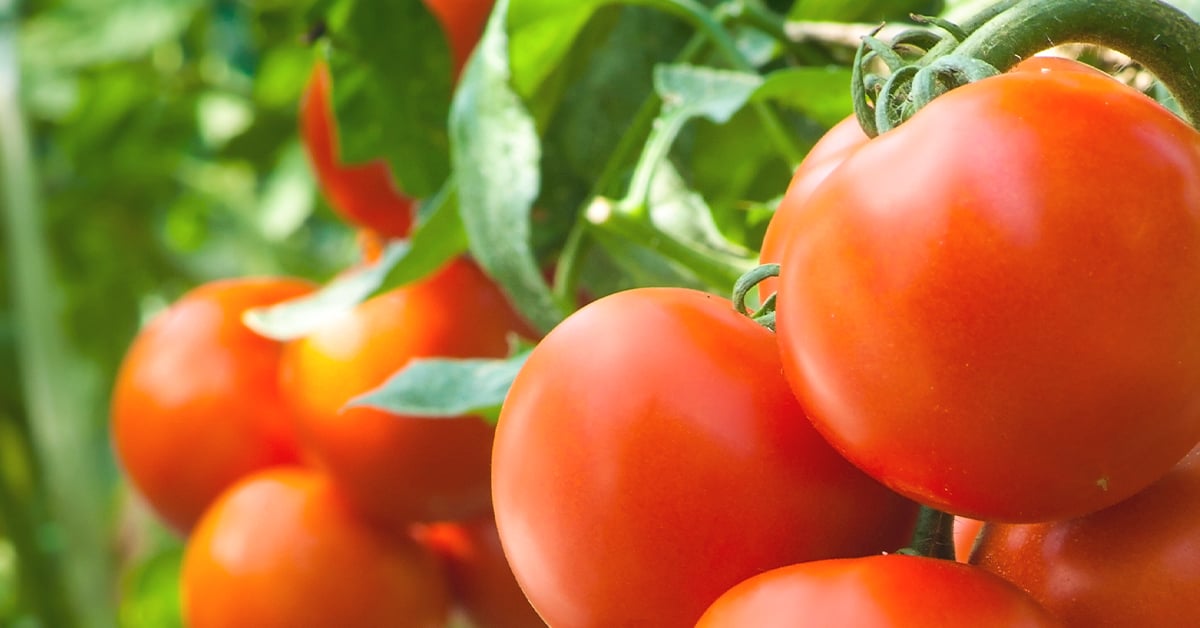
As gardeners, we love to grow all of our favorite vegetables. We’re selective in what we grow, and our gardens are planned each year around our personal favorites. With all of the options, few compare in popularity to tomatoes.
Tomatoes are delicious and versatile—and while they’re botanically identified as fruits—the U.S. Supreme Court classified them as vegetables. Either way, tomatoes are fun, fairly easy to grow, and likely to be the number one go-to plant in your garden.
Give your tomato plants the love they need from day one. Provide them a great start with proper nourishment and care, and you’ll enjoy the very best tomatoes this summer.
Give Your Tomatoes a Great Start
Tomato plants do well in warmer soil, so it’s best to start planting after the last spring freeze, usually between April and June (depending on where you live). When you’re choosing a space to start growing your tomato plants, pick a spot that receives full sun for at least eight hours a day.
Next, start your tomatoes off right by adding composted organic matter and an all-purpose fertilizer to the soil before planting. Both provide much-need nutrients to help stimulate growth. Your fertilizer should be low in nitrogen, high in phosphorus and medium to high in potassium (See: IFA Premium Garden Blend Fertilizer 16-16-8 or Fertilome Blooming & Rooting 9-58-8). Just be careful on how much you apply and follow the directions on the label. Too much fertilizer can cause leaf growth and delay fruit set and maturity.
Additionally to picking the right spot and prepping it for your new starts, plant your tomato seedlings deep. Tomato plant stems are different from most plants. If you plant them so most of the stem is under the soil, the stem will develop more roots. This allows the plants to function better in cooler soil, have access to more moisture and nutrients, and better handle the summer heat.
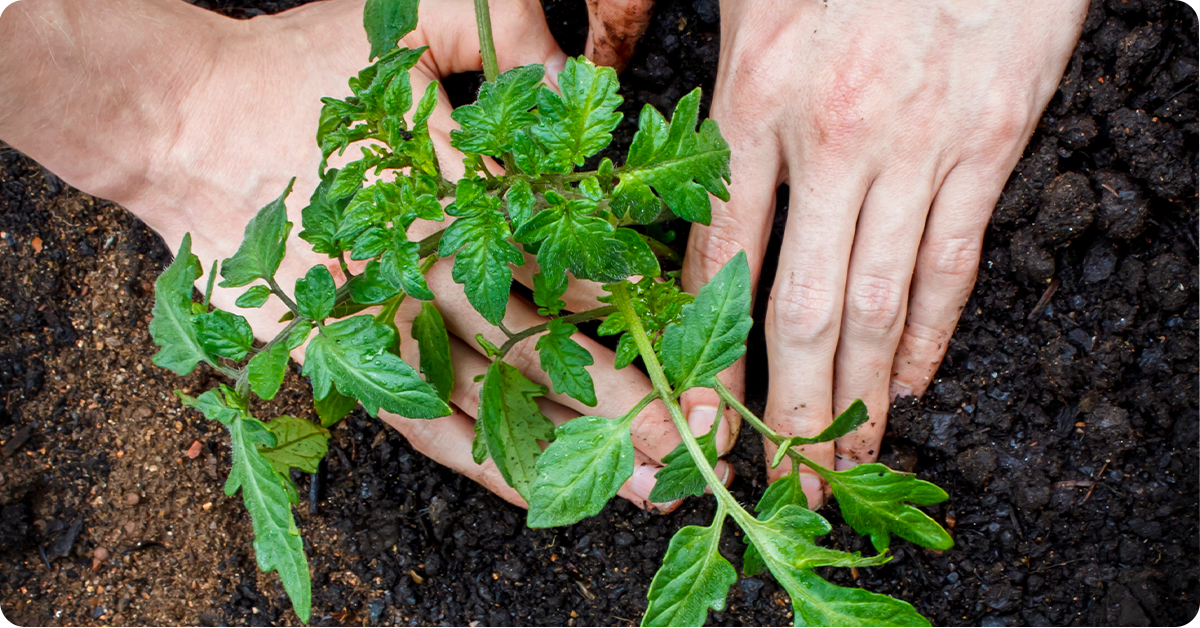
Water Your Tomatoes Thoroughly
Your tomatoes will need 1–2 inches of water per week. The best methods include drip irrigation, furrow or flood irrigation. Soak thoroughly on a consistent basis rather than giving your plants a light sprinkling every day. This will encourage a strong, deep root system. Once the tomato plants grow bigger, you may decrease watering to once or twice a week at the most.
Mulching around the base of your plants can help the root zone conserve water, while also warming the soil and helping to prevent weeds. Choose either an organic mulch, straw, compost, paper or black plastic. If you add black plastic, it allows for earlier planting and maturity, especially with transplants. Simply, lay out the plastic before planting, secure the edges with soil, and cut holes for seeds or transplants.
Whether you’re growing your plants in a garden or container, avoid overwatering your tomatoes. Too much water can result in fungus problems and roots dying.

Growing Tomatoes in Pots and Containers
Growing fresh, delicious tomatoes doesn’t necessarily mean you need to have space for a garden! Any sunny location with fertile, well-drained soil will give your plants a great start, whether that’s in your garden or in a pot on your deck or patio.
However, tomato plants growing in small containers or pots may require watering more often because they tend to dry out quickly. Make sure to check the soil for moisture daily by sticking your finger 1-2 inches below the surface. This will allow you to determine if the soil is truly dry or not.
Another important detail about growing tomatoes in a container is giving your plants a strong structure to grow beside. Try to add support for the stem after it’s established strong roots, but before it’s gotten too tall.
How to Maintain Healthy Tomato Plants
Once your tomatoes are started and growing strong, it’s important to maintain their health. Tomatoes are susceptible to a number of diseases and pests. Here are six common issues to be aware of, along with recommended treatments.
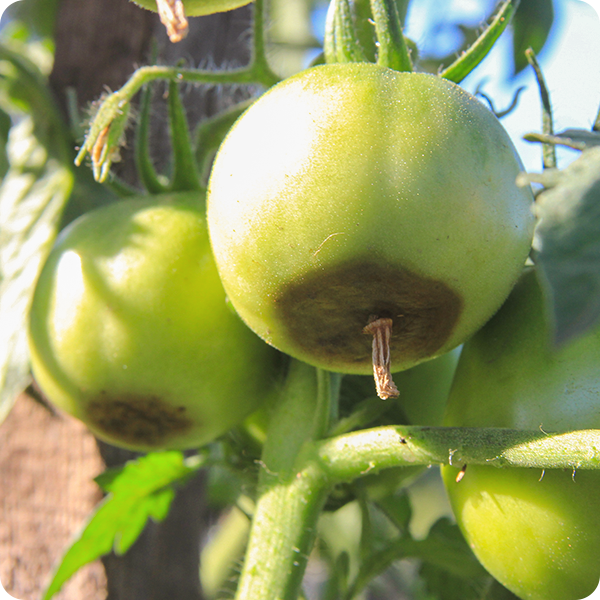 |
Blossom-End RotA typical problem every summer, blossom-end rot is generally caused by inconsistent watering (too much or too little), which leads to calcium depletion. To prepare for it, add calcium nitrate to the soil when planting, then when the tomatoes are about the size of a quarter, and again two weeks after picking the first ripe fruit. Apply the calcium nitrate as a side-dress, an application in a shallow furrow along the side of the vegetable row or in a circle around individual plants. Along with adding calcium nitrate, adjust your watering to be more routine, deep and less frequent. |
 |
Curly TopThis virus, carried by the beet leafhopper, causes leaves to turn upward and yellow, purple-colored veins, premature fruit and stunts growth. If your plant becomes infected, those parts need to be removed. |
 |
Early BlightYour plant starts to show brown spots, then the leaves turn yellow and fall off. Early blight is usually avoided by rotating crops annually (planting crops in different spots each year) and using fungicides. |
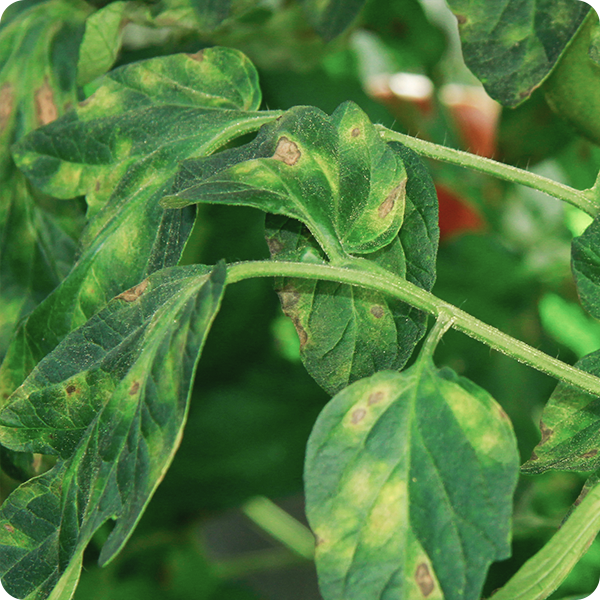 |
Septoria Leaf SpotHigh humidity, high temperatures and overhead watering can cause lower leaves to develop dark brown circular spots with a yellow ring. It’s one of the most destructive fungal diseases on tomato foliage and usually appears after the first fruit sets. Once again, rotate crops and avoid overhead watering. Some fungicides will help as well. |
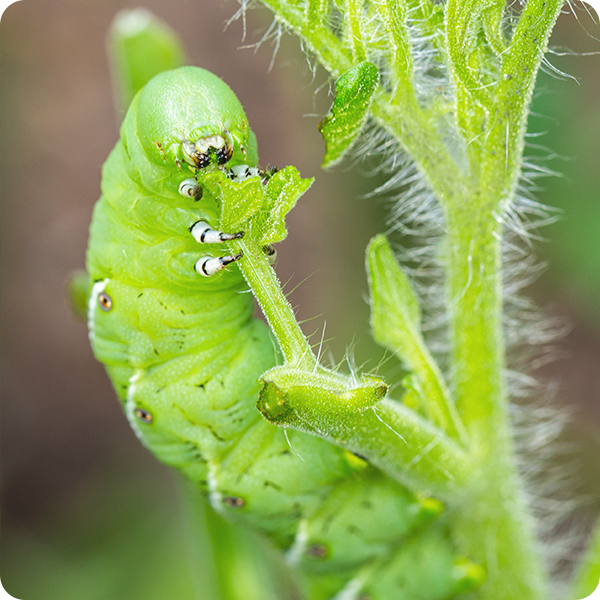 |
HornwormsThese green caterpillar pests can quickly ruin your tomato crops. They blend in well with the green foliage and feed non-stop, stripping all the leaves off your plant, devouring flowers, and damaging fruit. Control hornworms by picking them off your plant or applying insecticides or insecticidal soaps. Till the soil at the beginning and ending of each gardening season, keep beneficial insects around (such as ladybugs), and plant dill, basil or marigolds nearby. |
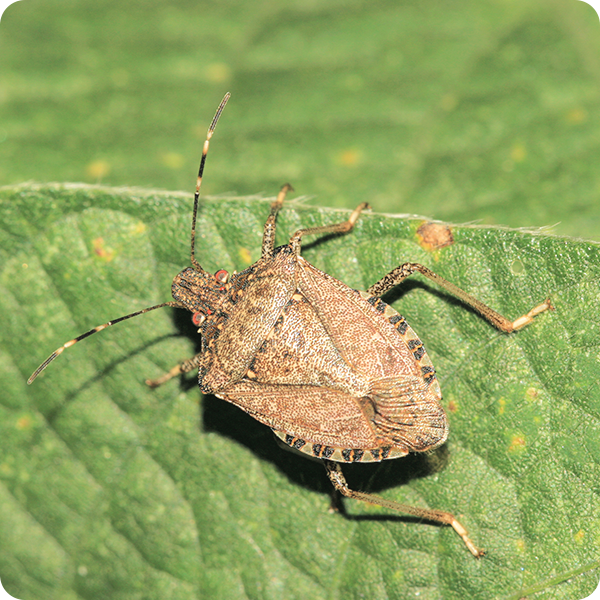 |
Stink BugsBrown to green, shield-shaped pests with straw-like mouthparts used to pierce leaves, stems and fruit. They cause discoloration in your tomatoes, and lay round to barrel-shaped eggs in clusters on leaves. Prevent them with insecticides, such as Sevin. |
You can help prevent all of these problems by using drip irrigation as opposed to overhead watering. Sprinkling creates a better environment for bugs and disease to grow.
If you do choose to apply an insecticide, fungicide or fertilizer, always make sure to study and follow the directions on the label.
Keys For Growing Productive Tomatoes
Planting Tomatoes in Early Spring
Growing the perfect tomato depends on several factors, including temperature, sunlight, pollination and the plant itself. If daytime temperatures exceed 95 degrees and nighttime temperatures drop below 50 degrees, tomatoes may experience shock or don’t set fruit as well and flowers will abort.
When planting tomatoes, it's ideal to wait until after the threat of the last frost. However, you can also plant them sooner with a little protection. Keep an eye on the temperatures of the area your plant is growing. If it drops below 40 degrees, cover your plants. Buckets, milk jugs with the bottom cut out, wax-paper Hotkaps, frost blankets, and Season Starter (formerly Wall O Water) insulated plant protectors all serve as great protectors for your tomato plants in early spring. When using the Season Starters, set them up a few days before planting. The multi-chamber design works similarly to a miniature greenhouse and will begin heating the soil. The warmer soil combined with protection from frost will help you get a head start on the growing season.

However, if the weather changes and the day is warm and sunny, remove the covers so your plants can breathe. It can become hot inside and potentially overheat the plant. On these days, remove the cover in the morning and put it back on in the evening. Season Starters can simply be opened up on the top to allow the plant to breath during warmer daylight hours.
Fertilize, Pollinate and Transplant
If you want to increase production, try a light feeding of nitrogen until the plant gets to the desired size and then feed it with phosphorus to encourage bloom growth. Also, tomatoes are wind pollinated, so giving your plants an occasional light shake can help increase pollination.
When transplanting your tomatoes to the garden, make sure to pinch off any flowers. This will help your plants utilize their energy on growth early-on and develop stronger root systems. It’s also a great time to place wood stakes or wire cages with your plants. Either provides ideal support for your plants and keeps ripening fruits off the ground.
Start Growing
Ultimately, have fun in your garden. Experiment with different techniques and varieties of tomato, but always grow what you love. Provide your tomatoes with a great start and proper care, and you’ll receive sweet results.
As always, IFA Country Stores is here to help. We hope these tips will give you a great start to growing the very best tomatoes this summer.
Information for this article was provided by Brenda Christophersen, Garden Center Manager, Ogden IFA Country Store; Brinn Hutcheon, Garden Center Asst. Manager, Riverton IFA Country Store; and Kent Mickelsen, Utah Certified Nurseryman, IFA Country Store.
IFA Vegetable Planting Guide:
